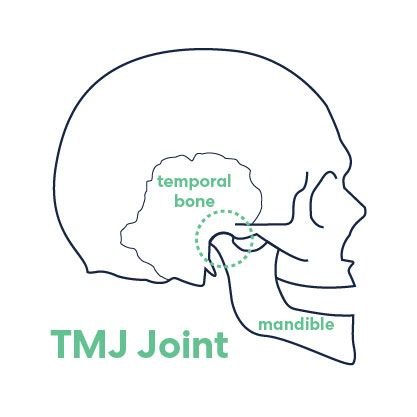
TMJ Pain: 6 Exercises & Stretches
The temporomandibular joint (TMJ) acts like a sliding hinge, connecting your jawbone to your skull. You have one joint on each side of your jaw. TMJ disorders— a type of temporomandibular disorder or TMD— can cause pain in your jaw joint and in the muscles that control jaw movement. 1 It is a common location of pain most commonly due to poor posture, overuse, & stress. The following exercises can help with posture correction, facial or jaw strength, and stabilization to decrease and prevent recurrent TMJ pain.
-
Resting Position
Reduce pressure caused by clenched teeth.
Reps: Do this as often as possible throughout your day.
-
Mouth slightly open
-
Lips gently together
-
Teeth not touching
-
Tongue gently resting on roof of mouth
-
Slight chin tuck
-
Shoulders gently pulled back
-
Chin Tucks
Activate and strengthen depp neck flexors to provide improved posture and stability.
Reps: 5 sets of 10 throughout the day.
-
Gently bring your chin straight back, as if you are giving yourself a double chin.
-
Thoracic Extension
Correct imbalances caused from poor posture.
Reps: 5 minutes or 30 reps throughout the day.
-
Option 1: Lie flat on your back for 5 minutes a day without a pillow.
-
Option 2: In a sitting position, lean backward over the chair back.
-
Shoulder External Rotation
Correct imbalances caused from poor posture .
Reps: 3 sets of 20 reps throughout the day
-
Hold a band* shoulder-width apart with palms facing up and elbow bent to 90 degrees.
-
Slowly pull the band apart while pinching your shoulder blades together in the back. Remember to keep your shoulders relaxed/down and elbows next to your sides.
*This exercise can be done with or without a band.
-
Jaw Distraction Strength
Gentle stretch to relieve pressure.
Reps: Hold for 10 seconds, repeat 10x, 3-4 times/day.
-
Place hands on either side of the jaw and relax your jaw as much as possible. Gently add pressure and pull down on your jaw until a light stretch is felt.
-
Isometrics
Strengthen the muscles around the TMJ & increase stability.
Reps: Hold each position for 3-5 seconds, repeat 10x before switching positions.
-
Place your hand on various places on the jaw, providing resistance from movement.

Download the free PDF version to take with you on the go. To speak with one of our physical therapists about TMJ pain, contact us today!
